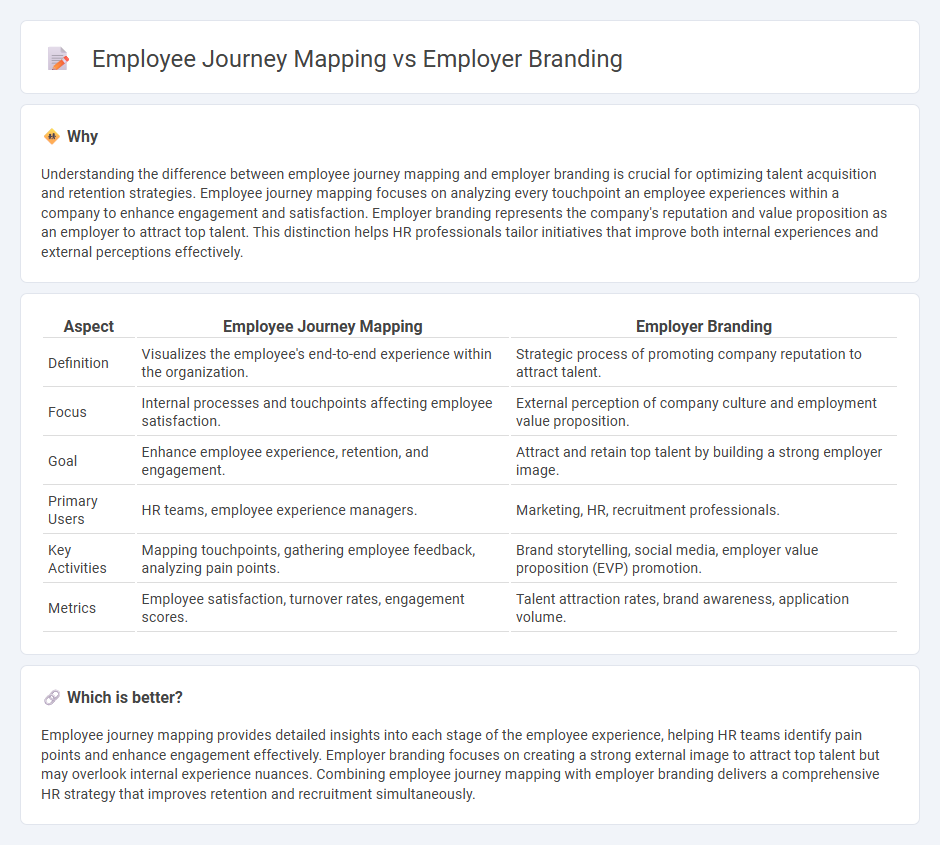
Employee journey mapping systematically analyzes each interaction employees have with their organization, highlighting key touchpoints that impact engagement and retention. Employer branding focuses on shaping a company's reputation to attract and retain top talent by communicating its values, culture, and benefits. Explore the detailed strategies behind employee journey mapping and employer branding to enhance your human resources initiatives.
Why it is important
Understanding the difference between employee journey mapping and employer branding is crucial for optimizing talent acquisition and retention strategies. Employee journey mapping focuses on analyzing every touchpoint an employee experiences within a company to enhance engagement and satisfaction. Employer branding represents the company's reputation and value proposition as an employer to attract top talent. This distinction helps HR professionals tailor initiatives that improve both internal experiences and external perceptions effectively.
Comparison Table
| Aspect | Employee Journey Mapping | Employer Branding |
|---|---|---|
| Definition | Visualizes the employee's end-to-end experience within the organization. | Strategic process of promoting company reputation to attract talent. |
| Focus | Internal processes and touchpoints affecting employee satisfaction. | External perception of company culture and employment value proposition. |
| Goal | Enhance employee experience, retention, and engagement. | Attract and retain top talent by building a strong employer image. |
| Primary Users | HR teams, employee experience managers. | Marketing, HR, recruitment professionals. |
| Key Activities | Mapping touchpoints, gathering employee feedback, analyzing pain points. | Brand storytelling, social media, employer value proposition (EVP) promotion. |
| Metrics | Employee satisfaction, turnover rates, engagement scores. | Talent attraction rates, brand awareness, application volume. |
Which is better?
Employee journey mapping provides detailed insights into each stage of the employee experience, helping HR teams identify pain points and enhance engagement effectively. Employer branding focuses on creating a strong external image to attract top talent but may overlook internal experience nuances. Combining employee journey mapping with employer branding delivers a comprehensive HR strategy that improves retention and recruitment simultaneously.
Connection
Employee journey mapping identifies key touchpoints shaping workforce experiences, directly influencing employer branding by highlighting areas for improvement and authentic engagement. Clear mapping ensures consistent messaging and positive perceptions, strengthening the employer's reputation in talent markets. Integrating these strategies enhances recruitment, retention, and overall organizational culture alignment.
Key Terms
**Employer Branding:**
Employer branding shapes a company's reputation and value proposition to attract top talent by highlighting culture, mission, and employee benefits. It differentiates the organization in competitive job markets through strategic storytelling and consistent messaging across platforms. Discover how strong employer branding drives recruitment success and employee engagement.
Employee Value Proposition (EVP)
Employer branding centers on promoting the company's Employee Value Proposition (EVP) to attract and retain top talent by highlighting unique workplace culture, benefits, and growth opportunities. Employee journey mapping focuses on analyzing each touchpoint of the employee experience to enhance satisfaction and engagement, ensuring the EVP is effectively delivered throughout the employment lifecycle. Explore how integrating EVP into both strategies can optimize talent management and drive organizational success.
Talent Attraction
Employer branding shapes a company's reputation to attract top talent by showcasing its culture, values, and benefits, while employee journey mapping analyzes the candidate and employee experiences to identify touchpoints that influence talent attraction and retention. Both strategies optimize recruitment by aligning organizational messaging with the actual experiences of potential and current employees, enhancing engagement and satisfaction. Explore how integrating these approaches can elevate your talent acquisition strategy and strengthen workforce alignment.
Source and External Links
What is Employer Branding? Definition ... - Employer branding is the strategic process of creating and maintaining your company's reputation as a great place to work, focusing on culture, values, and employee benefits to attract and retain talent.
Employer branding - Employer branding is the practice of marketing the entire employment experience, shaping an organization's reputation as a desirable workplace and defining its employee value proposition to attract, engage, and retain talent.
What is employer branding? - Employer branding refers to how your company is perceived as a place to work by current, past, and potential employees, influencing talent attraction, employee engagement, and retention.
 dowidth.com
dowidth.com